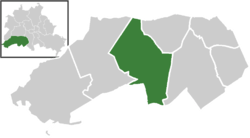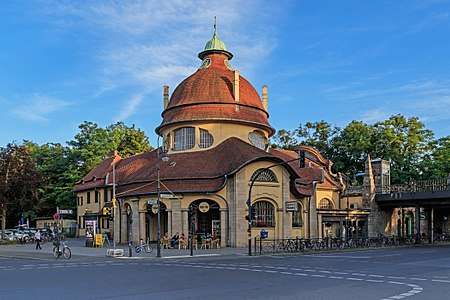Zehlendorf (Berlin)
Zehlendorf (![]()
Zehlendorf | |
|---|---|
Quarter of Berlin | |
St. Matthew's Church in Steglitz is owned and used by a congregation within the Evangelical Church of Berlin-Brandenburg-Silesian Upper Lusatia, a united church body of Calvinist, Lutheran and united congregations. | |
 Coat of arms | |
Location of Zehlendorf in Steglitz-Zehlendorf and Berlin  | |
 Zehlendorf  Zehlendorf | |
| Coordinates: 52°26′N 13°12′E | |
| Country | Germany |
| State | Berlin |
| City | Berlin |
| Borough | Steglitz-Zehlendorf |
| Founded | 1200 |
| Subdivisions | 6 zones |
| Government | |
| • Mayor | Norbert Kopp (CDU) |
| Area | |
| • Total | 18.8 km2 (7.3 sq mi) |
| Elevation | 50 m (160 ft) |
| Population (2008-06-30) | |
| • Total | 57,902 |
| • Density | 3,100/km2 (8,000/sq mi) |
| Time zone | CET/CEST (UTC+1/+2) |
| Postal codes | (nr. 0604) 14163, 14165, 14167, 14169 |
| Vehicle registration | B |
History
The village of Zehlendorf was first mentioned as Cedelendorp in a 1245 contract between the Margraves John I and Otto III of Brandenburg and the Lehnin Abbey. Probably a German foundation, the name Cedelen may refer to a former Slavic settlement from the 7th century, or be a dialect word for "settlement" (modern German Siedlung), or "noble" (Cedelendorp = Cedelen + dorp, "noble village" (see Jahresbericht über die Erscheinungen auf dem Gebiete der germanischen Philologie)
In the affluent and well-educated environment of Zehlendorf, top World War II figures mingled with opponents of the Nazi regime. Express S-Bahn trains, known as the "Banker Trains" whisked them at 120 km/h (75 mph) to the financial and government centers until the service was disrupted towards the end of World War II.[1]
During the Nazi period Zehlendorf's mayor was Walter Helfenstein (1890-1945), a convinced Nazi. Helfenstein was responsible for erecting a memorial to the antisemitic publisher Theodor Fritsch (1853-1933), described as "the first antisemitic memorial in Germany"[2] in Zehlendorf in 1935. The memorial was the first memorial sculpted by the artist Arthur Wellmann (1885-1960), who was a Zehlendorf resident (and who, after producing other Nazi memorials, including one to the SA, eventually emigrated to the United States).[3][4] The Fritsch memorial was melted down in 1943 to make armaments for the war.[5] Mayor Helfenstein committed suicide on 24 April 1945 as the Red Army took Berlin.[6] Helfenstein's death is referred to in the novel Berlin by the anti-Nazi novellist Theodor Plievier.
Geography
Subdivision
Zehlendorf is subdivided into 6 zones:
- Düppel
- Schlachtensee-Ost
- Schönow/Zehlendorf-Süd
- Zehlendorf-West
- Zehlendorf-Ost
- Zehlendorf-Nord (Onkel-Tom-Siedlung)
Locale
Visitors can stop at the Dahlem Church, where the vicar, Pastor Martin Niemöller, served from 1931 through 1937. Niemöller's sermons against the Nazis led to his imprisonment and the publication of them in English during the war helped shape discussion of the nature of National Socialism in Christian circles.[7]
Many walking trips are available in and around Zehlendorf. Popular destinations include the Grunewald trails north from the Onkel Toms Hütte U-Bahn station and neighborhood shopping center, the walk from Krumme Lanke U-Bahn station to the lake of the same name, and the cross-Zehlendorf walk from the end of the U-Bahn at Krumme Lanke to the S-Bahn station in the center of old Zehlendorf. Zehlendorf shopping center has undergone major changes with plenty of new construction centering on the S-Bahn station "Zehlendorf".
When American forces occupied Berlin and later were stationed in Berlin during the Cold War, Zehlendorf with the "Steuben Barracks", Dahlem and Lichterfelde were the areas where most of those forces were centered, including elements of the Berlin Brigade stationed at the [[McNair Barrack )) </ref>
Transportation
There is direct access to central Berlin via road and S-Bahn. The S1 line makes 3 stops in Zehlendorf and runs right through Unter den Linden, where the Brandenburg Gate is located. The newer portion of the borough of Zehlendorf developed around extended U-Bahn service in the first third of the 20th Century. It may be reached via the U3 line at the station Onkel Toms Hütte and the terminus Krumme Lanke.
The Bundesstraße 1 federal highway runs through the locality along the streets Berliner Straße, Potsdamer Straße and Potsdamer Chaussee. Zehlendorf has also access to the A 115 Autobahn (the former AVUS racing track) at the Hüttenweg junction.
Points of interest
Gallery
 Village church
Village church Peaceful snowscape as seen during a U.S. Army patrol in Zehlendorf's forest
Peaceful snowscape as seen during a U.S. Army patrol in Zehlendorf's forest_Rosa_Wegner.jpg) Stolperstein in Zehlendorf
Stolperstein in Zehlendorf View of the former synagogue in Steglitz, Berlin
View of the former synagogue in Steglitz, Berlin Berlin Mexikoplatz Station
Berlin Mexikoplatz Station
References
-
- Dittfurth, Udo and Braun, Dr. Michael; "Die elektrische Wannseebahn"; Verlag GVE; Berlin; 2004; page 82. This book also has additional historical information about 20th Century Zehlendorf.
- https://m.tagesspiegel.de/berlin/bezirke/steglitz-zehlendorf/politik-des-hasses-zehlendorf-im-nationalsozialismus-das-erste-antisemitische-denkmal-deutschlands/9057034.html
- https://www.sports-reference.com/olympics/athletes/we/arthur-wellmann-1.html
- http://www15.ovgu.de/mbl/Biografien/1432.htm
- W. Benz, B. Mihok, et al. - Literatur, Film, Theater und Kunst Theodor-Fritsch Denkmal (Berlin, 1935-1943 (De Gruyter Oldenbourg, 2014)
- https://m.tagesspiegel.de/berlin/bezirke/steglitz-zehlendorf/ausstellung-zum-80-jahrestag-der-machtergreifung-zehlendorf-wurde-braun/8807876.html
-
- Preface by Thomas Mann in Niemoeller, Martin; "God is My Fuehrer"; Philosophical Library and Alliance Book Corporation; New York, 1941, pages 3-14.
External links
| Wikimedia Commons has media related to Berlin-Zehlendorf. |
| Wikivoyage has a travel guide for Zehlendorf. |
- "Berlin 1969" From the American era.
- Century-old villa holds secrets In German.
